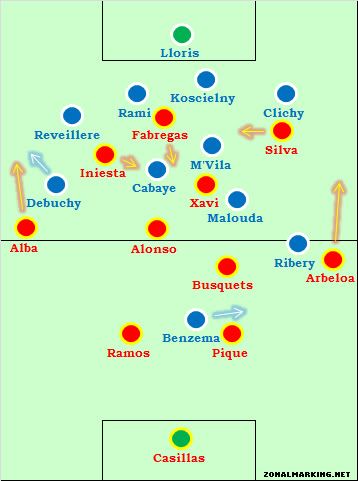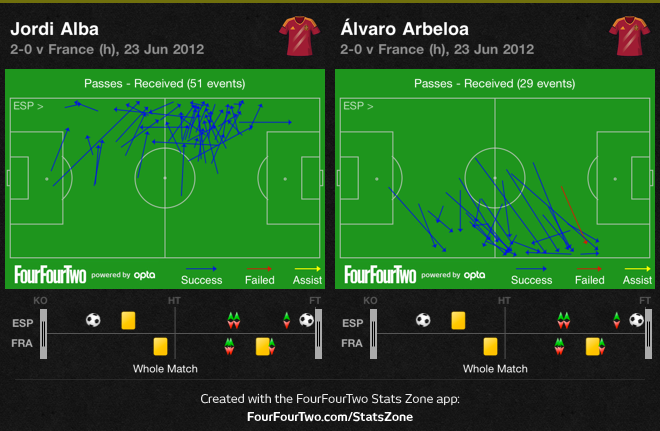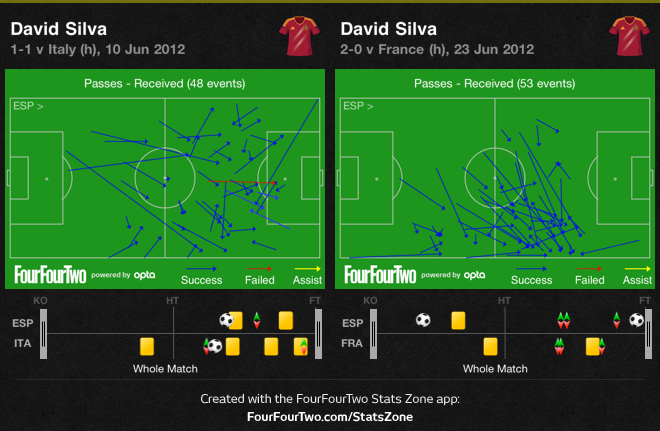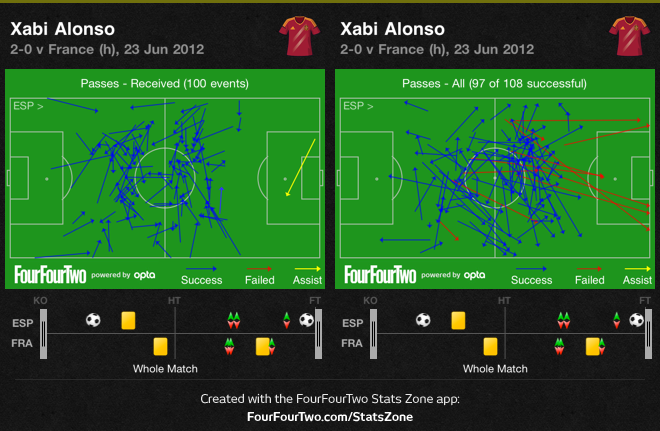|
|
本帖最后由 Alex2011 于 2012-6-28 00:18 编辑
Spain 2-0 France: Blanc’s double right-back plan fails and Alonso deservedly scores both goals
June 24, 2012

The starting line-ups
Laurent Blanc named an extremely reactive team – but France neither stifled Spain’s threat down the left, nor played their own game effectively.
Vicente del Bosque had hinted he would make changes from the team that beat Croatia, though it was still a surprise to see Cesc Fabregas return to the side in a false nine role, meaning Spain played the XI that started against Italy in the opening game – an experiment that didn’t go well.
Blanc’s XI was a huge surprise. He named Mathieu Debuchy on the right side of midfield, practically given a man-marking job on Jordi Alba. That meant Anthony Reveillere made his first start of the tournament at right-back. Florent Malouda was given a role in the centre of midfield, while Samir Nasri was only on the bench. France had come to contain rather than to attack.
But their performance was remarkably feeble. Their gameplan from the outset failed, and Blanc then found himself unable to react effectively at 1-0 down. Spain weren’t spectacular, but they were clearly the better side.
France right / Spain left
There’s no getting away from the game’s main story. Blanc decided to field two right-backs in tandem, which was paying a huge compliment to Jordi Alba, Spain’s left-back. As it happens, Alba is part of the most successful double-full-back combination in Europe at the moment, playing behind Jeremy Mathieu at Valencia. Alba plays a very important role in the Spanish side – ZM pinpointed him as (possibly) Spain’s key player pre-tournament, because he’s the only man who offers width. Blanc’s thinking was this – if you nullify Alba, you make Spain congested and predictable in the centre of the pitch.
It was certainly a brave decision, arguably a foolish one. What it showed, though, was how one moment can change how a manager’s entire tournament decision-making will be viewed – Debuchy’s stumble when attempting to track Alba’s run for Xabi Alonso’s opening was unfortunate from Blanc’s point of view (he can hardly legislate for a player simply losing his footing) but it meant his gameplan had failed.
For the rest of the game, Alba wasn’t such a big influence. But France had to be completely secure down that side for such a deliberate, obvious strategy to be rendered a success.
Spain right / France left
On the other side, Blanc’s strategy was completely different. Alvaro Arbeloa against Franck Ribery seemed the key battle before the game, and Arbeloa’s runs went completely unchecked throughout the first half – he constantly moved forward on the overlap, and Ribery had no intention of marking him. France didn’t believe Arbeloa was good enough on the ball to cause them any harm – although the Spanish players didn’t seem to have much more faith. A delayed pass from Fabregas early on, when he used Arbeloa as a last resort despite the right-back being in an excellent position, showed how reluctant they were to use them. Had Alba (or Dani Alves at Barcelona) been in that position, Fabregas would have played the ball immediately.
As shown below, Alba was involved in build-up play much more, with Arebloa the crossfield option.

Ribery could have countered, as he did against Ukraine, but Spain made sure the right-back position was covered, with Sergio Busquets moving across to defend that side of the pitch when Arbeloa went forward. It was more important to cover the right than the left, of course, as Ribery stayed high up and remained a threat, while Debuchy was moving back with Alba.
Spain movement
Spain may have played the same system as against Italy, but it was completely different performance. There was so much more variety in their play – Xavi Hernandez played higher up, making the formation less 4-3-3 and more 4-2-3-1, offering a clear forward pass for the other two midfielders. David Silva stretched the play more, staying wider (see below) when Spain had the ball at the back, and moving inside when Arbeloa wanted to get forward, rather than doing so incessantly for the sake of it. The tempo of the passing was better, with Alonso more forward-thinking with his distribution – and even without his goals, he was Spain’s star man.

There was also good movement from the front three. Iniesta drifted inside, dragging Reveillere into uncomfortable positions and opening up space for the Alba v Debuchy battle, while Fabregas’ movement drew Adil Rami forward. Laurent Koscielny covered, and France rarely seemed likely to be opened up through the centre, but it was a much more promising situation than against Italy, where Cesare Prandelli’s side often had three spare men.
Alonso
By wasting two players on the right, it’s arguable France conceded too much room in midfield. There, the midfield roles were unclear, and the main man to benefit was Alonso. Xavi played higher up and often found himself surrounded, but Yohan Cabaye was slow to press Alonso and therefore the Real Madrid midfielder was the game’s most prolific passer. It’s not often he outperforms Xavi for Spain (in terms of passing figures, and overall influence on the game) – but he did so tonight, and deserved to be in the headlines for his goalscoring.
There may have been a few too many unsuccessful straight passes, but we can hardly criticise him for that, having given Spain stick for playing sideways too frequently.

France with the ball
France were extremely poor on the ball in the first half – Spain pressed them well, but France resorted to long balls too often, and too readily. The role of Malouda was particularly unclear – presumably he was meant to shuttle forward and link midfield and attack, but Blanc dropped him after the England game because he failed to do that effectively, and his selection was more baffling than that of Debuchy, which at least had a clear (if unsuccessful) purpose.
If Blanc wanted defensive strength he could have used Alou Diarra, if he wanted creativity he could have used Nasri. Malouda was the best of neither world, and just as Alonso’s key role was summed up by his headed finish for the first, Malouda was responsible for the goal, with some utterly non-existent defending. That said, after the first three games, midfield runs from Spain was something of a shock…
There was no transition plan – Busquets shut out Ribery, Karim Benzema was isolated. France couldn’t turn all-out-defence into any form of attack.
Second half
This was, frankly, a complete non-event. France managed zero shots on target, Spain mustered one – which came in the 89th minute, from the penalty spot. It was a poor half of football contested between two teams playing within themselves – France because they lacked organisation, Spain because they weren’t forced to be good.
The substitutions were vaguely interesting, but more for the coaches’ intentions than the resulting impact upon the game. Blanc used Nasri in place of Malouda, and Jeremy Menez for Debuchy, and more of a clear 4-2-3-1. Nothing much changed, and the subsequent introduction of Olivier Giroud for M’Vila was a final, desperate roll of the dice – but it meant France struggled to win the ball .
Del Bosque used Pedro Rodriguez in place of Silva, though he played wide on the left, with Iniesta moving to the right. Torres replaced Fabregas and tried to hold the ball up – neither sub changed the game significantly, though Pedro won the penalty for Alonso’s second.
Boring Spain?
Spain will face more accusations of “boring football” after coasting their way through this match. That’s terribly harsh – for over 70 minutes of the game they were ahead and content to slow the tempo, while France struggled to win the ball, or do anything with it.
It was fair to criticise Spain for being unambitious and unimaginative with the ball when they were drawing 0-0 against Italy (and looking more likely to concede than score), and also against Croatia when they came close to not topping the group having lacked penetration throughout. Even the 45 minute spell between the first and second goals against the Republic of Ireland was hugely frustrating, because Spain were being dull against probably the competition’s weakest side.
But here, determined ball retention was completely justifiable from a tactical point of view. If your side is 1-0 up at half-time, and you manage to go the entire second half without conceding a shot on target, your gameplan has been successful.
There was little difference from previous games in terms of pure playing style - but the scoreline for most of the game was 1-0 and not 0-0. That might not placate those who want more of a spectacle. But the difference in the situation of the game translates into the difference between Spain playing poorly, and Spain playing effective, controlled defensive football to maintain a lead.
Conclusion
“We were strong on the left with Jordi and Iniesta, that’s where the first goal came from,” said del Bosque.
“If you look at our team, we knew Spain’s left side was very strong,” Blanc said. “In Alba and Iniesta, they have two players who overlap constantly. And what’s frustating is that we conceded a goal from that side. If you look at the first half, it’s the only time Alba was able to put a cross in…it’s a frustrating feeling. We knew they were dangerous on that side, we changed our team to compensate, and they score from that side.”
You can question Blanc’s approach, but you can’t fault his summary. |
|

